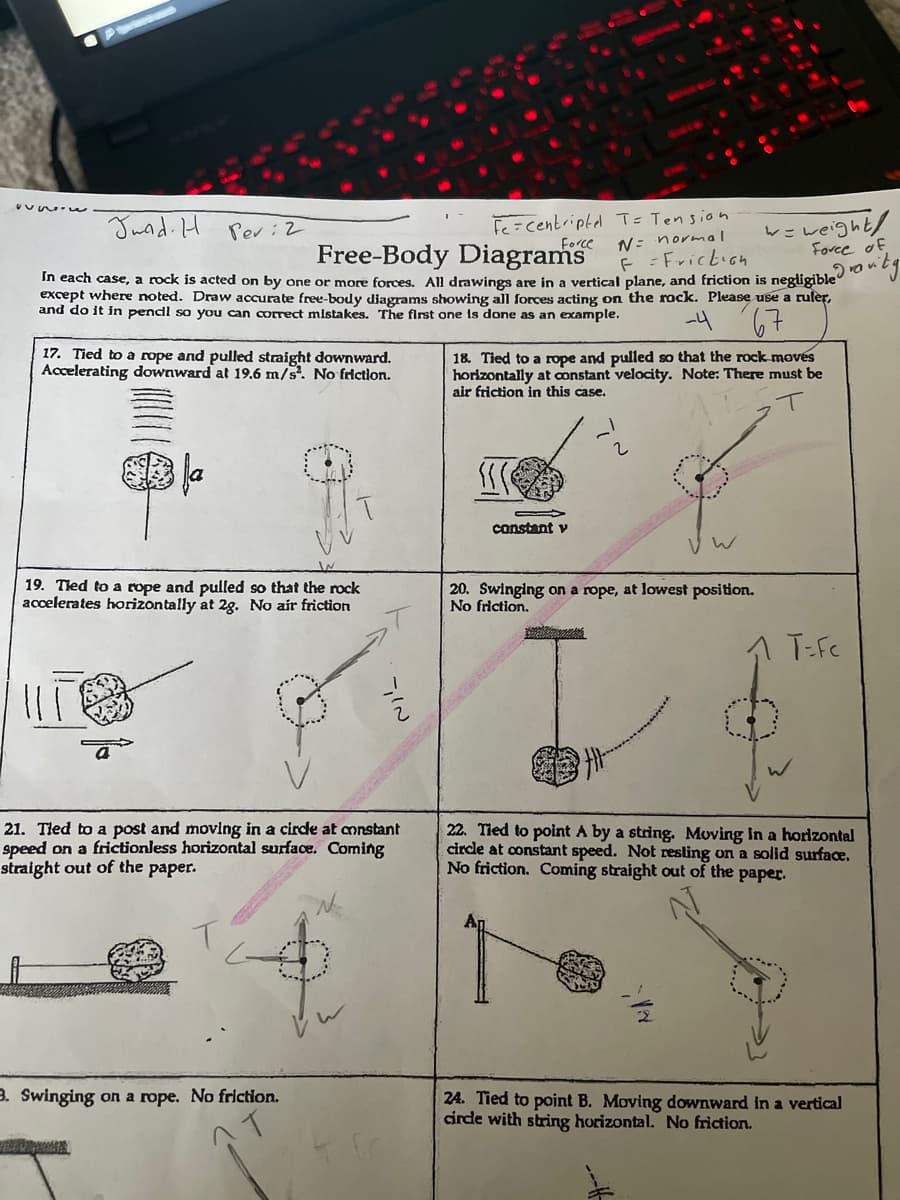Glencoe Physics: Principles and Problems, Student Edition
1st Edition
ISBN:9780078807213
Author:Paul W. Zitzewitz
Publisher:Paul W. Zitzewitz
Chapter1: A Physics Toolkit
Section: Chapter Questions
Problem 7STP
Related questions
Question
Number 18

Transcribed Image Text:Juad. H Per:2
Fe=centriptel T= Tension
Force
N= normal
F=Frickion
w=weight/
Force of
Free-Body Diagrams
In each case, a rock is acted on by one or more forces. All drawings are in a vertical plane, and friction is negligible
except where noted. Draw accurate free-body diagrams showing all forces acting on the rock. Please use a ruler,
and do it in pencil so you can correct mistakes. The first one Is done as an example.
67.
17. Tied to a rope and pulled straight downward.
Accelerating downward at 19.6 m/s. No friction.
18. Tied to a rope and pulled so that the rock movés
horizontally at constant velocity. Note: There must be
air friction in this case.
constant v
19. Tied to a rope and pulled so that the rock
accelerates horizontally at 2g. No air friction
20. Swinging on a rope, at lowest position.
No friction.
1 T=fC
21. Tled to a post and moving in a circe at constant
speed on a frictionless horizontal surface. Coming
straight out of the paper.
22. Tied to point A by a string. Moving in a horizontal
circle at constant speed. Not resling on a solid surface.
No friction. Coming straight out of the paper.
3. Swinging on a rope. No friction.
24. Tied to point B. Moving downward in a vertical
circde with string horizontal. No friction.
IN
Expert Solution
This question has been solved!
Explore an expertly crafted, step-by-step solution for a thorough understanding of key concepts.
This is a popular solution!
Trending now
This is a popular solution!
Step by step
Solved in 2 steps with 1 images

Knowledge Booster
Learn more about
Need a deep-dive on the concept behind this application? Look no further. Learn more about this topic, physics and related others by exploring similar questions and additional content below.Recommended textbooks for you

Glencoe Physics: Principles and Problems, Student…
Physics
ISBN:
9780078807213
Author:
Paul W. Zitzewitz
Publisher:
Glencoe/McGraw-Hill

Principles of Physics: A Calculus-Based Text
Physics
ISBN:
9781133104261
Author:
Raymond A. Serway, John W. Jewett
Publisher:
Cengage Learning

Glencoe Physics: Principles and Problems, Student…
Physics
ISBN:
9780078807213
Author:
Paul W. Zitzewitz
Publisher:
Glencoe/McGraw-Hill

Principles of Physics: A Calculus-Based Text
Physics
ISBN:
9781133104261
Author:
Raymond A. Serway, John W. Jewett
Publisher:
Cengage Learning